
In 2018, around 90% of the South Africa’s electricity was produced by burning coal in a fleet of ageing power stations, but the contribution of wind and solar to the electricity mix has been steadily increasing. In January 2025, renewables generated 16.3% of the country’s electricity, up from 4.9% in 2018, according to Ember data.
In January 2025, the proportion generated by coal dropped to 74%, a new low that prompted the Minister of Forestry, Fisheries and the Environment, Dr Dion George, to issue a celebratory media statement. In it he said he looks forward to seeing continued increases in solar and wind power, alongside a sustained decrease in coal reliance.
Coal’s contribution to the electricity mix dips in the summer months between November and January and rises in the winter months, the data shows. So it’s likely to increase again as the temperature cools.
Solar and wind are the two main renewable electricity sources in South Africa. Wind has hovered at around 5% of the electricity mix since late 2022, which is also when coal’s contribution dropped below 80% for the first time. Solar, which also tends to dip a little in the winter months and peak in summer, has risen from 4% of the mix in January 2022 to 11.2% in January 2025.
Get the data used in this chart on DataDesk
In January 2025, the proportion generated by coal dropped to 74%, a new low that prompted the Minister of Forestry, Fisheries and the Environment, Dr Dion George, to issue a celebratory media statement. In it he said he looks forward to seeing continued increases in solar and wind power, alongside a sustained decrease in coal reliance.
Coal’s contribution to the electricity mix dips in the summer months between November and January and rises in the winter months, the data shows. So it’s likely to increase again as the temperature cools.
Solar and wind are the two main renewable electricity sources in South Africa. Wind has hovered at around 5% of the electricity mix since late 2022, which is also when coal’s contribution dropped below 80% for the first time. Solar, which also tends to dip a little in the winter months and peak in summer, has risen from 4% of the mix in January 2022 to 11.2% in January 2025.
Get the data used in this chart on DataDesk
